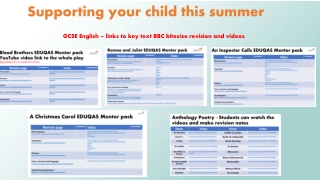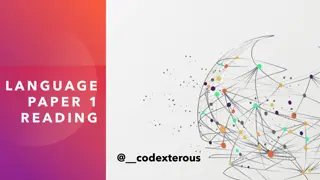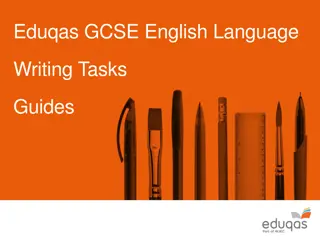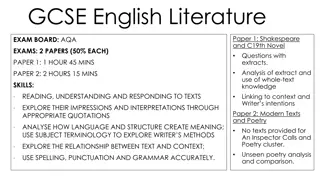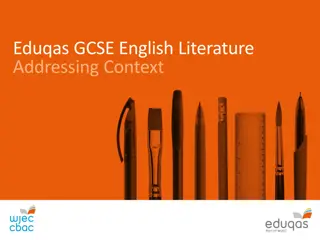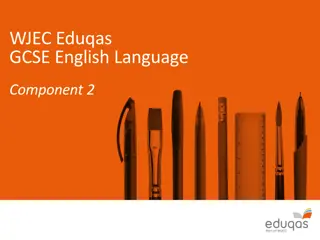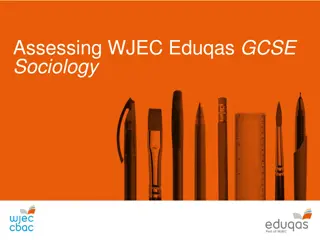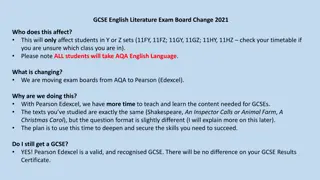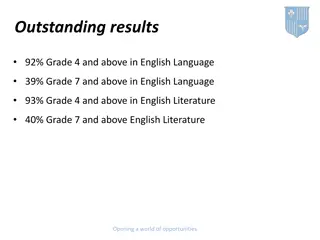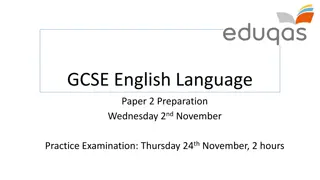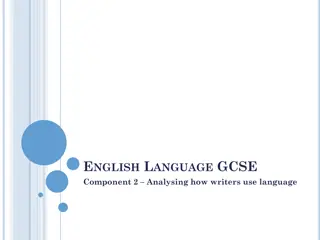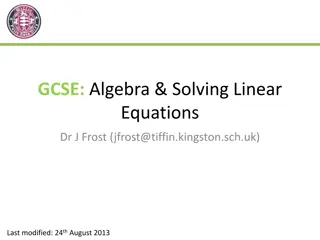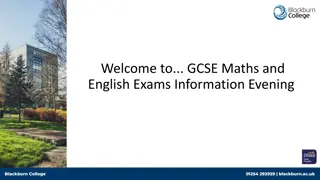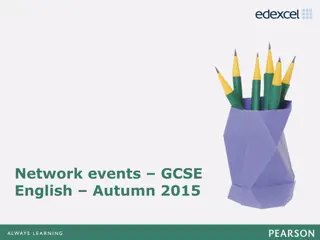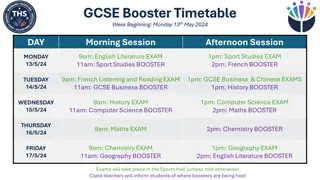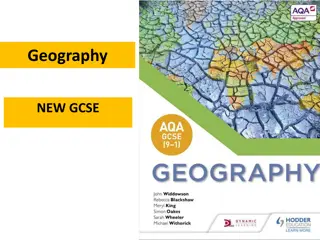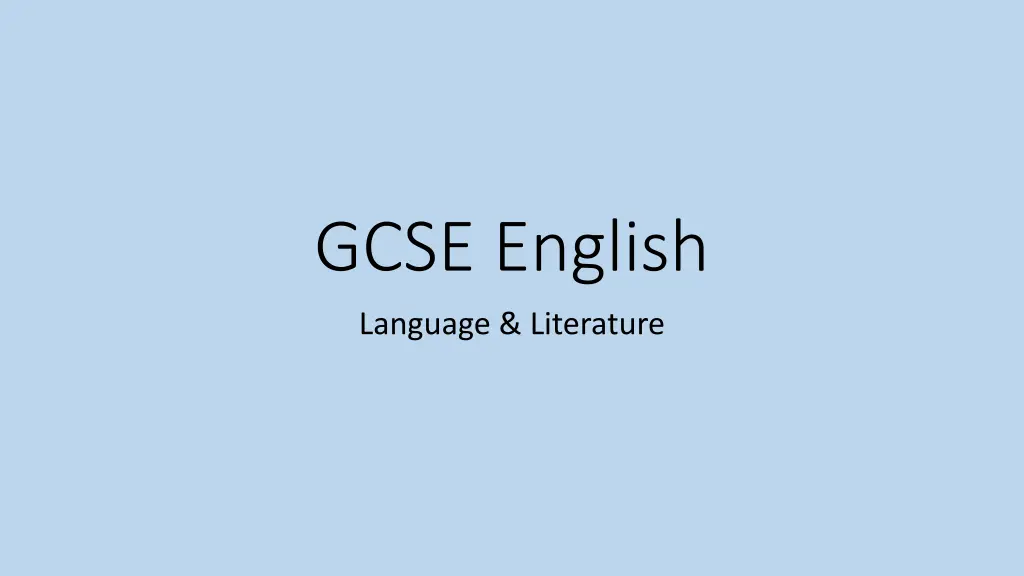
GCSE English Language and Literature Preparation Guide
Prepare for your GCSE English Language and Literature exams by completing class work, reading set texts, using online resources, and practicing key skills like analysis and creative writing. Learn about the exam structure and content breakdown for AQA GCSE English Language.
Download Presentation

Please find below an Image/Link to download the presentation.
The content on the website is provided AS IS for your information and personal use only. It may not be sold, licensed, or shared on other websites without obtaining consent from the author. If you encounter any issues during the download, it is possible that the publisher has removed the file from their server.
You are allowed to download the files provided on this website for personal or commercial use, subject to the condition that they are used lawfully. All files are the property of their respective owners.
The content on the website is provided AS IS for your information and personal use only. It may not be sold, licensed, or shared on other websites without obtaining consent from the author.
E N D
Presentation Transcript
GCSE English Language & Literature
GCSE English Language and GCSE English Literature Four papers (two for Language, two for Literature) 100% Exam (no Coursework or Controlled Assessment) Single tier (no more Higher and Foundation; all pupils sit the same exams)
What should students be doing to prepare? Complete class work and homework to the best of their ability Reading read the set texts, read the notes made in class, read poetry, read novels, read the newspaper, read as much as possible and discuss what you have read. Recommended 19thCentury texts: Wilde, The Picture of Dorian Gray Shelley, Frankenstein Wells, The Time Machine Stoker, Dracula Use the internet there are great resources online https://www.youtube.com/user/mrbruff https://www.youtube.com/ Stacey Reay http://genius.com/ For the poetry https://www.memrise.com/ For memorising quotations
Skills tested across the two GCSEs: Analysis Comparison Creative writing Evaluation Structural features SPaG (spelling, punctuation & grammar) Interpret Name (identify) Get by heart (memorise)
AQA GCSE English Language Overview: First Assessment 2017 (100% Exam) What must students cover? What is the percentage breakdown of these elements? Paper One: Explorations in Creative Reading and Writing One Hour 45 Minutes. 80 Marks. (50%) Paper Two: Writer s viewpoints One Hour 45 Minutes. 80 Marks. (50%) Section b) Narrative / Descriptive Writing (25%) 40 marks Section a) Literary Fiction (20th/21st C) (25%) 40 marks Section b) Narrative / Descriptive Writing (25%) 40 marks Section a) Non Fiction and Literary Non- Fiction including 19th C (25%) 40 Marks What will the exams be like? What questions will the students be asked? What understanding must they demonstrate? Students write their own text giving a written perspective of the theme in section a). Students will work with an Insert containing two non-fiction texts of different genres linked by a similar theme. Students must consider descriptive and narrative approaches such as narrative perspectives atmosphere, characterisation, effective openings and endings. Students will be given one extract from a piece of Prose Fiction Students will be answer four questions: 1) A short four mark question focussed on information retrieval 2) An 8 mark question analysing the use of language 3) An 8 mark question focussed on the analysing structural features 4) A 20 mark extended question focussing on a critical response to a particular aspect of the text e.g. characterisation Students write their own creative text inspired by the topic in section a). One text will be from the 19th Century and one from either the 20th or 21st Century depending on the time period assessed in Paper One. This allows students to consider perspectives through time. Students will be answer four questions: 1) A short 4mark question focussed on information retrieval. 2) An 8 mark question summarising details from both texts 3) An 12 mark question focussed on the analysing language from the 19th C text. 4) A 16 mark extended question comparing attitudes conveyed in each text Students will be given a prompt, either a written prompt or an image. Students will be given a prompt, such as an opinion, statement or scenario to provoke a response There will be a choice of two scenarios from which students will select one. The written task will define the audience, purpose and form required. Each scenario will define the audience, purpose and form of the writing task Students will need to adapt their language, register and form to meet the requirements of the task How does this relate to the Assessment Objectives and the weightings? Q1: AO1 4 Marks. Q2: AO2 8 Marks Q3: AO2 8 Marks Q4: AO4 20 Marks Q1: AO1 4 Marks. Q2: AO1 8 Marks Q3: AO2 12 Marks Q4: AO3 16 Marks AO5: 24 Marks AO6: 16 Marks AO5: 24 Marks AO6: 16 Marks Reading Objectives Paper One % 2.5% Paper Two % 7.5% Total % 10% Writing Objectives Paper One % Paper Two % Tota l % AO 1 Identify and Interpret Explicit and implicit information and ideas Select and synthesise evidence from different texts Explain, comment on and analyse how writers use language and structure to achieve effects and influence readers, using relevant subject terminology to support their views AO3: Compare writers ideas and perspectives, as well as how these are conveyed, across two or more texts Evaluate texts critically and support this with appropriate AO5 Communicate clearly, effective and imaginatively, selecting and adapting tone, style and register for different forms, purposes and audiences. Organise information and ideas using structural and grammatical features to support coherence and cohesion of texts AO6 Use a range of vocabulary and sentence structures for clarity, purpose and effect, with accurate spelling and punctuation 15 15 30 AO 2 10% 7.5% 17.5% AO 3 AO NA 10% 10% 10 10 20 12.5% NA 12.5%
AQA GCSE English Literature Overview: First Assessment 2017 (100% Exam) What must students cover? What is the percentage breakdown of these elements? Paper Two: Modern Texts, Anthology Poetry and Unseen Poetry Two hours 15minutes. 96 Marks. 60% Paper One: Shakespeare and 19th Century Novel One Hour 45 Minutes. 64 Marks. (40%) Section b) 19th C Novel (20%) 30 marks Section a) Shakespeare (20%) 30 marks (4 marks SPAG) Section c) Unseen Poetry (20%) 32 Marks Section b) Anthology Poetry (20%) 30 marks Section a) Modern Texts (20%) 30 marks (4 marks SPAG) What will the exams be like? What questions will the students be asked? What understanding must they demonstrate? Students are given a choice of two essay questions on their chosen text and must answer one. Students will be given one poem from the anthology they have studied. This text will be readable. Students will be given an extract from their chosen text. The paper will give a brief explanation of the context of this scene Students will be given an extract from their chosen play. The paper will give a brief explanation of the context of this scene This section of the paper is in two parts. Part a is worth 24 marks. Students will be given an unseen poem with an accompanying essay question These questions may be about character, theme, or a combination of the two. Students will give one essay question. They must write in detail about the extract and write about the play as a whole. Students will give one essay question. They must write in detail about the extract and write about the play as a whole. Students will be asked one comparative essay question about the given poem and another poem from the anthology of their choice. Students must demonstrate character and thematic understanding across the whole play. Part b is worth 8 marks. Students will be given another unseen poem and will a comparison question about a shared theme / idea of the two unseen poems. Students must demonstrate character and thematic understanding across the whole play. Students must demonstrate character and thematic understanding across the whole play How does this relate to the Assessment Objectives and the weightings? A01: 12 Marks A02: 12 Marks A03: 6 Marks Part a: A01: 12 Marks A02: 12 Marks Part b: A02: 8 marks A01: 12 Marks A02: 12 Marks A03: 6 Marks A04: 4 marks A01: 12 Marks A02: 12 Marks A03: 6 Marks A04: 4 marks A01: 12 Marks A02: 12 Marks A03: 6 Marks A01: 24 A03: 12 Marks (15% of GCSE) A02: 24 Marks (15% of GCSE) (7.5% of GCSE) A04: 4 marks (2.5% of GCSE) A01: 36 Marks A03: 12 Marks (22.5% of GCSE) A02: 44 Marks (27.5% of GCSE) (7.5% of GCSE) A04: 4 marks (2.5% of GCSE) A01 Read, understand and respond to texts: Analyse the language, form and structure used by a writer to create meanings and effects, using relevant subject terminology where appropriate. Show understanding of the relationships between texts and the contexts in which they were written. maintain a critical style and develop an informed personal response use textual references, including quotations, to support and illustrate interpretations. 37.5% A02 A03 42.5% 15% AO4 Use a range of vocabulary and sentence structures for clarity, purpose and effect, with accurate spelling and punctuation. 5%
ENGLISH LANGUAGE (8700) -Paper 1 Explorations in creative reading and writing For Paper 1 the texts will be extracts from literature prose fiction (such as novels and short stories) and will focus on: openings endings narrative or descriptive passages character development atmospheric descriptions
ENGLISH LANGUAGE (8700) -Paper 1 Explorations in creative reading and writing A quick glance format for Paper 1 (creative texts) questions: Q1 Identify & interpret (AO1) 4 marks Q2 Language analysis (AO2) 8 marks Q3 Structure (AO2) 8 marks Q4 Evaluate (AO4) 20 marks Q5 Descriptive or Narrative writing (AO5/6) 40 marks
AO1 Q1 Identify and Interpret Identify and interpret explicit and implicit information and ideas List 4 things .. Marks Given 4 marks Max Time spend: 6 minutes Make: 4 points Select and synthesise evidence from different texts. Identify explicit information Identify explicit ideas Underline keywords in the question Read the text & highlight 4 main points linked to the question Out these key points in your own words or quote them Make sure each point is different
Point Q2 language Evidence Explain How does the writer s use of language AO2 Explain, comment on and analyse how writers use language and structure to achieve effects and influence readers, using relevant subject terminology to support their views Marks Given 8 marks Max Time spend: 12 minutes Make approx: 3-4 points Comment, Explain, Analyse This question assesses language words/phrases / language features / language techniques / sentences Use language terminology Select relevant quotations Explain and analyse the effects of the writer s choices of language
Q3 structure Point Evidence How does the structure Explain Marks Given 8 marks Max Time spend: 12 minutes Make approx: 3-4 points AO2 Explain, comment on and analyse how writers use language and structure to achieve effects and influence readers, using relevant subject terminology to support their views Comment, Explain, Analyse This question assesses structural features: Of the whole text like beginnings/endings: changes in viewpoint At paragraph level such as topic change/single sentence paragraphs At sentence level such as sentence length Use language terminology Select relevant references from the text Explain & analyse the effects of the writer s choice of structural features
Q4 Evaluate texts AO4 Evaluate texts critically and support this with appropriate textual references To what extent do you agree Marks Given 20 marks Max Time spend: 30 minutes Make approx: 6+ points Make a personal judgement with references to the text You will be given a statement about the text to discuss Write about your own ideas & interpretations of the text Evaluate what the writer has achieved Select relevant quotations from the text Explain and analyse the effects of the writer s choices
Paper 1, English: Section B Writing 40 marks 45 minutes Take risks with vocabulary use impressive and ambitious word choices even if you aren t sure of the spellings!
Q5 Descriptive or Narrative writing 5 mins planning 40 minutes writing 3-4 sides 24 marks content and organisation 16 marks accuracy Inform Facts, opinions, statistics, statements, adjectives, subject specific terms, lists Explain Reasoning, facts, personal opinions and feelings, statement sentences, comparisons, repetition, anecdotes, direct address Discursive markers and Connectives: The reason for, So, The main factor, therefore, when, as a result, moreover, consequently, because, which leads to, furthermore, the consequence of is Describe create a picture or a visual image for your reader be creative and ambitious with vocabulary choices. Maintain past or present tense throughout AO5 Content and Organisation Communicate clearly, effectively and imaginatively, selecting and adapting tone, style and register for different forms, purposes and audiences. Organise information and ideas, using structural and grammatical features to support coherence and cohesion of texts. Start with: A short or one word sentence A sense (sound/smell/touch/sight/taste) Adverb ( ly word) A complex sentence / subordinate clause A preposition (above, opposite, under, over)
Spelling, punctuation and grammar: 16 marks CAPITAL letters names/places Commas after connectives (firstly) and between items in lists Apostrophes John s belonging to John Colons ( ) introduces lists or reasons Semi colons (;) link two similar sentences or separate phases Exclamations (!) emphasis Dashes ( - ) creates a pause and add additional information Questions marks (?) even on rhetorical questions Ellipsis ( ) creates a pause or a cliffhanger Interrobang (?!) use occasionally Don t forget paragraphs! No paragraphs No C grade! Sentence types: Simple/short Compound (and/but/or) Complex Adverb starts (ly words) One word sentences for effect Repetition of sentences and within sentences for effect Punctuation: It must be accurate It must be varied AO6 Technical Accuracy Candidates must use a range of vocabulary and sentence structures for clarity, purpose and effect, with accurate spelling and punctuation. (This requirement must constitute 20% of the marks for each specification as a whole.) Spellings: There a place (here and there) Their belonging to them (it is their cat) They re short form of they are (they re coming to my party) Your belonging to you (that is your dog) You re short form of you are (you re late again)
AQA Paper 2: English language Section A Reading 40marks Spend 1 hour
Q1 Identify and Interpret AO1 List 4 things .. Identify and interpret explicit and implicit information and ideas. Select and synthesise evidence from different texts. Marks Given 4 marks Max Time spend: 6 minutes Shade: 4 boxes shaded Identify explicit information Identify explicit ideas Underline keywords in the question Read the text Shade the boxes of the statements you think are true Make sure you only shade 4 boxes
Point from Text 1 with quotation Q2 Summarise Write a summary 8 marks 12 minutes Interpret information Point from Text 2 with quotation Identify and Interpret Select and synthesise information from different texts Interpret information & make links between the texts Underline relevant information in both texts Interpret this information to answer the question Show clear connections between the texts Use relevant quotations to support points from both texts AO1 Identify and interpret explicit and implicit information and ideas Select and synthesise evidence from different texts
Q3 language Point How does the writer s use of language Evidence Marks Given 12 marks Max Time spend: 18 minutes Make approx: 4 points Explain Comment, Explain, Analyse AO2 Explain, comment on and analyse how writers use language and structure to achieve effects and influence readers, using relevant subject terminology to support their views This question assesses language words/phrases/language features/language techniques /sentences Use language terminology Select relevant quotations Explain and analyse the effects of the writer s choices of language
Q4 Compare texts AO3 Compare writers ideas and perspectives, as well as how these are conveyed, across two or more texts Compare how the writers present Marks Given 16 marks Max Time spend: 24 minutes Make approx: 5 points Compare writers ideas & viewpoints, and how they are shown Devices to compare: Direct address (you/your) Metaphors, similes, imagery Imperative verbs (commands) Hyperbole (exaggeration) Rhetorical questions Connectives: In a similar way / in comparison On the other hand / however In contrast / whereas Explanation phrases Suggests / implies / conveys / evokes / indicates
Paper 2: English: Section B Writing 40 marks 45 minutes
Q5 (6) Argue, Inform, Explain writing about your own point of view AO5 Content and Organisation Communicate clearly, effectively and imaginatively, selecting and adapting tone, style and register for different forms, purposes and audiences. Organise information and ideas, using structural and grammatical features to support coherence and cohesion of texts. 5 mins planning 40 minutes writing 2-3 sides 24 marks content and organisation 16 marks accuracy Start with a powerful statement, fact, statistic or rhetorical question You need to present your reader with a clear set of logical ideas about a topic. You need to show consideration of alternative views to your own. CONNECTIVES to develop ideas: TIPS: You MUST use devices throughout your response: Rhetorical questions 3 part list Exaggeration (hyperbole) Comparisons through imagery (simile, metaphor) Emotive language Anecdotes (personal stories & details or a case study) Firstly, secondly, in addition / Additionally, Furthermore, Moreover, In contrast, On the other hand, Alternatively, Finally, In conclusion Give articles a heading Set out letters the correct way
Spelling, punctuation and grammar: 16 marks AO6 Technical Accuracy Candidates must use a range of vocabulary and sentence structures for clarity, purpose and effect, with accurate spelling and punctuation. (This requirement must constitute 20% of the marks for each specification as a whole.) Don t forget paragraphs! No paragraphs No C grade! Sentence types: Simple/short Compound (and/but/or) Complex Adverb starts (ly words) One word sentences for effect Repetition of sentences and within sentences for effect CAPITAL letters names/places Commas after connectives (firstly) and between items in lists Apostrophes John s belonging to John Colons ( ) introduces lists or reasons Semi colons (;) link two similar sentences or separate phases Exclamations (!) emphasis Dashes ( - ) creates a pause and add additional information Questions marks (?) even on rhetorical questions Ellipsis ( ) creates a pause or a cliffhanger Interrobang (?!) use occasionally Punctuation: It must be accurate It must be varied Spellings: There a place (here and there) Their belonging to them (it is their cat) They re short form of they are (they re coming to my party) Your belonging to you (that is your dog) You re short form of you are (you re late again)
English Literature 8702 An important note at the start: All exams are now closed text, so students will have to memorise quotations. Extracts are provided for some, but not all, of the Literature questions.
English Literature 8702 Paper 1: Shakespeare and the 19th-century novel (64 marks) (40%) 1 hour and 45 minutes: Extracts are provided for both questions Section A: Shakespeare Students will answer one question on their play of choice. (In the first year all students will be taught Macbeth in order to aid the recall of quotations). They will be required to write in detail about an extract from the play and then to write about the play as a whole. Section B: The 19th-century novel Students will answer one question on their novel of choice (this will either be The Strange Case of Dr. Jekyll & Mr. Hyde or A Christmas Carol depending on what they have studied in class). They will be required to write in detail about an extract from the novel and then to write about the novel as a whole.
Shakespeare: Macbeth A brief explanation of where the extract sits within the story will be provided An extract from a key scene in the play will be provided for the student, but they will have to remember quotations from the rest of the play. I would recommend looking at both questions straight away and writing down useful quotations immediately in order to have the best chance of remembering them. The question will be linked to the extract and will be on a main character like Lady Macbeth, or a theme, for example ambition. The student will need to analyse quotations from the extract (three quotations) Then analyse quotations they have remembered from the rest of the play (three quotations)
19th Century Novel: Jekyll & Hyde or A Christmas Carol A brief explanation of where the extract sits within the story will be provided An extract from a key passage in the novel will be provided for the student, but they will have to remember quotations from the rest of the novel. I would recommend looking at both questions straight away and writing down useful quotations immediately in order to have the best chance of remembering them. The question will be linked to the extract and will be on a main character like Hyde/Scrooge or a theme, for example the uncanny. The student will need to analyse quotations from the extract (three quotations) Then analyse quotations they have remembered from the rest of the novel (three quotations)
English Literature 8702 Paper 2: Modern texts and poetry (96 marks) (60%) 2 hours and 15 minutes: Extracts are not provided for the play. The named poem is provided in Section B and the Unseen poems are provided in Section C Section A: Modern texts Students will answer one essay question from a choice of two on their studied modern prose or drama text (this will be either DNA or An Inspector Calls). Section B: Poetry Students will answer one comparative question on one named poem printed on the paper and one other poem from their chosen anthology cluster (Conflict Cluster). Section C: Unseen poetry Students will answer one question on one unseen poem and one question comparing this poem with a second unseen poem.
Modern text: DNA or An Inspector Calls Students will have a choice of two questions, they should answer only one question on the play that they have studied with their class teacher One of the questions is typically on a main character and the other on a theme. Students will need to remember six quotations. Swiss army knife quotations
Conflict Poetry: Ozymandias I met a traveller from an antique land, Who said Two vast and trunkless legs of stone Stand in the desert. . . . Near them, on the sand, Half sunk a shattered visage lies, whose frown, And wrinkled lip, and sneer of cold command, Tell that its sculptor well those passions read Which yet survive, stamped on these lifeless things, The hand that mocked them, and the heart that fed; And on the pedestal, these words appear: My name is Ozymandias, King of Kings; Look on my Works, ye Mighty, and despair! Nothing beside remains. Round the decay Of that colossal Wreck, boundless and bare The lone and level sands stretch far away. The question will ask the student to compare the poem provided to another poem in the cluster they have studied. The question should refer to a theme or a structural element.
Unseen Poem In order to prepare students for the unseen element of the exam, a conflict poem is presented in class for students to analyse before the teacher begins to teach them this helps them to prepare for a poem they have not studied before. The question will ask the student to analyse and explain an aspect of the poem; a theme, the use of imagery or a structural element are the most likely topics for the questions.
Second Unseen Poem This second unseen poem will be linked to the first; this section of the exam is aimed more towards high achieving students in English, however there is no reason why all students should not attempt this question The final question will ask the student to compare the two unseen poems, in a similar way to the comparison question in Section B.
Skills tested across the two GCSEs: Analysis Comparison Creative writing Evaluation Structural features SPaG (spelling, punctuation & grammar) Interpret Name (identify) Get by heart (memorise)
References: @FKRitson @Team_English1 @AQAEnglish

